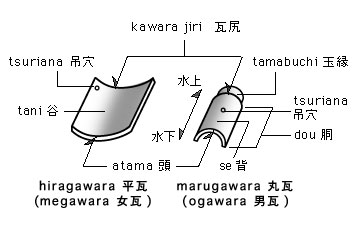Also called *megawara
女瓦 (female tile). One of the basic roofing tiles. The terms megawara
and *ogawara 男瓦 (male tile) were common but to some extent, megawara has been replaced by hiragawara,
and ogawara by *marugawara
丸瓦. A broad concave almost rectangular roof tile, that is arc-shaped in cross
section. It is used in conjunction with semi-circular tiles marugawara.
The concavity created a valley *tani 谷 which
carried off the rain water. It is usually slightly more narrow at the front end
atama 頭, than at the opposite end shiri 尻. Its size, thickness
and degree of concavity varied, being greater in the ancient period than in later
periods. Size varied, but was often 30cm long x about 27cm wide at the top, and
at the bottom end about 25.5cm wide. The concavity at the center was about 3.5mm.
Ancient tiles had less concavity than those made after the 12c. Dimensions of
the tiles are also dependent on the size of the roof. The larger tiles were easier
to lay and stabilize. If they were too small, the concavity would be too narrow.
As a result rain water could easily rise to the edges and even seep under the
marugawara and cause leaks. Hiragawara, in ancient times were made
by cutting a cylindrical tile into quarter sections from top to bottom.
|

